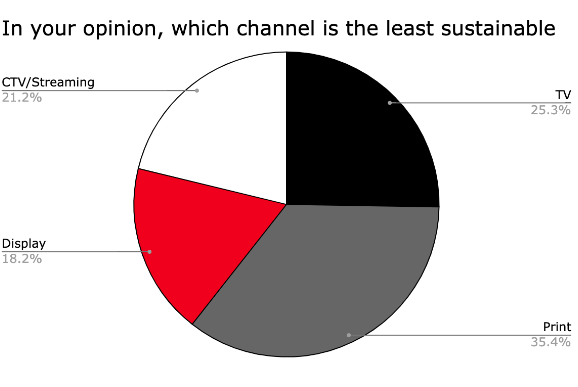
White Paper | Author: Shilpa Kolte, Xandr a Microsoft Company, CTV & Streaming Council subgroup
Sustainability is an important topic across multiple industries today. Many businesses today track their sustainability initiatives and provide transparency on efforts and outcomes, much like how they provide visibility to current and future investors in the public domain. The advertising industry is not immune to this sweeping change in the world.
According to The Drum, digital now has a greater share of Greenhouse Gas (GHG) emissions than the aviation industry and is continuing to grow. In recognising the need for sustainable business, Group M announced its plan earlier this year to develop a global framework to help reduce carbon emissions, providing information on which channels and even vendors have the highest impact.
Holding companies, platforms, and publishers too have their own initiatives to explore and reduce the impact their programmatic advertising efforts are having on the environment.
While this is relatively new for the industry it has become a focus point for many companies, most are still in the process of beginning to look at and understand their impact. In a recent survey on perceptions and practices, IAB SEA+India members were asked about their business approaches to sustainability, what sustainability means to them, and better understand what actions they are taking to address the issue. This survey provided interesting insights, which this article will highlight and suggest paths for the industry to move forward in building a sustainable ecosystem.
The current state of sustainability in ad tech
Sustainability, as widely understood, considers the environmental, social, and economic impact of human activity. Interestingly, in the survey, environmental impact was front and center for respondents, but the social impact was not lost within the member community.
It is hard to argue that digital advertising does not have an environmental impact, but the IAB SEA+India survey found interesting insights about the perceptions of different formats among members. Most believe CTV and streaming advertising is more sustainable than print and TV advertising, however less so than display ads.
The order of impact, as perceived, was Print>TV> CTV> Display.
Since there is not much data around the environmental impact of different ad formats, this was an interesting finding. While this is at a format level, we do not know yet the aggregate impact, considering some formats are very widely used but others not so.

While more than 86% of respondents are already considering the environmental impact of their advertising and how they can leverage more green energy to reduce negative outputs, around 9% are considering the social impact of their advertising. Employee burnout is not a new concern for many technology companies considering the human labor that is required to effectively deliver campaigns. With this, some companies reported that they are thinking about how they can help to make advertising more efficient, so that consumers are not overexposed and inundated with irrelevant ads, and there is limited impact on the workforce, which in turn can reduce environmental impact.
Today, 86% of the respondent companies have implemented some measures of sustainability within their business, especially around operational practices such as switching office lights off and cutting back on water usage. 23% of the responding companies have taken this a step further and applied this to their vendor selections to partner with those that are helping with carbon offsets. There are many buyers that are currently adopting supply path mapping as an important strategy to be more sustainable.
77% percent of survey respondents believed they will adapt to greener ways of advertising, yet 80% cited lack of knowledge of sustainable practices to be the biggest hindrance in moving forward.
Two key themes emerged from the survey:
1. Respondents have perceptions around climate impact of various formats.
2. There is strong willingness to do their part to become sustainable as an industry; however there is a lack of knowledge of the best ways of doing so.
Measuring sustainability
The survey underscored the need for further work in the field to understand the data on the environmental impact of individual digital formats and channels. It will help us figure out where and how we can offset them. For example, what we do not have today includes:
1. Data that talks of impact of each format at a single unit level. It is understandable that video will have more impact than display, but how does it compare with TV/print?
2. Aggregate impact of various formats – as some are niche while others are widespread.
Once we have better understanding at micro and macro levels, we can point the industry toward adopting more sustainable forms of advertising that aligns with consumer behavior while providing return on investment to brands.
Today, there are already industry efforts in place with some companies adopting supply path optimisation, or selection of vendors with sustainability credentials. We have also seen companies like Scope3 emerge to help further support and drive these efforts. Their work is aimed at quantifying impact and providing carbon offsetting opportunities. Additionally, Goodloop, launched a free tool for advertisers to measure the carbon impact of their digital campaigns.
At Xandr, we have recently launched a collaboration with Impact+ in order to bring greenhouse gas emissions measurement to our Invest DSP customers in France. Through this relationship, customers can learn which factors have the most impact on their emissions so they can then make decisions based on those metrics.
Addressing the challenge
As newer tools emerge to measure the impact of advertising on the environment, the challenges on how to negate or reduce those impacts are the next area to focus on.
We already have a baseline idea on which digital formats cause a larger environmental impact. What we need to have now is a view into how this measures up in aggregate. For example, if streaming ads on CTV with the rich video creatives cause higher energy consumption, the overall volume of all CTV advertising is so much smaller compared to the display ads being transacted at any given time. User preferences and advertising ROI also influence how we address the wider challenge in the industry.
CTV may still be one of the younger channels in digital advertising, but it has caught the attention of marketers and consumers alike. With consumer eyeballs shifting to streaming platforms at increasing rates, advertisers have invested more of their dollars into the format and that does not look like it will slow anytime soon.
The IAB SEA+India’s OTT, CTV and Streaming Guidebook notes that the video industry will be ~$4.5billion by 2025, in Southeast Asia alone. Given consumer preferences and industry trends, it is imperative to optimise the formats and volumes generated to balance the environmental load. It will need the industry to work together to bring ROI front and center and focus on efficient means of advertising, replacing volume of inventory with quality of inventory.
Some practices that are in place to provide sustainable means of advertising include:
-
-
Green Media Products: Where the impact of advertising is measured, and a contribution is made to carbon removal projects
-
Vendor selection: Media is purchased from/transacted with vendors who fulfil stipulated sustainability credentials
-
Technology: Through vendors like SeenThis, who are building emerging technologies that aim to provide seamless user experiences for video ads with a minimum amount of data consumption.
-
Ultimately, being able to effectively measure the impact of advertising activities will undoubtedly be crucial to point efforts in the right direction. As this survey was measuring perception and current state, having the right measurements will allow a cohesive effort from the industry towards sustainability. Sustainability will be most meaningful when the industry moves together collaboratively.
Education and awareness
Digital advertising remains a necessity for brands, especially given the digitisation of consumers’ daily lives. However, it is time that we as an industry start to examine our part and impact on the environment and determine the steps we can take to help mitigate them. The key to helping to do this is through education.
Overall, the survey found willingness from every respondent to be more sustainable but cited limited awareness of how to achieve it. More companies would be open to adopting practices that help make them more sustainable, but it still feels like there is a lack of knowledge on how best to do so.
As an industry we need to collectively come together to provide education to offer more understanding and guidance on how to reduce environmental impact. This will go a long way and help to make the industry more sustainable and build a better future not only for the advertising industry but for society as a whole.

